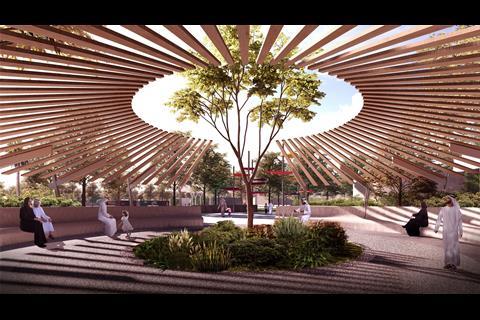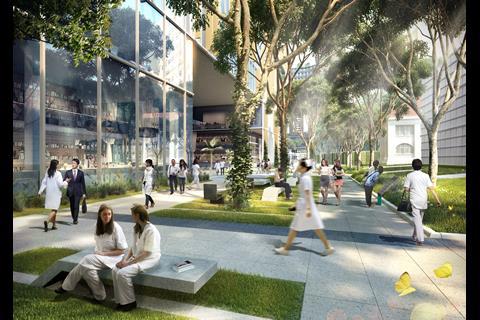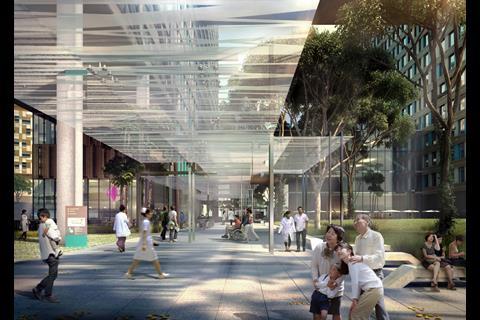If Britain is to become a world leader in climate-change adaptation then we need to focus on proven design solutions and open access to data, writes Ed Baker

This summer’s record-breaking heatwave was a clear demonstration of the need for planning reform across Britain. Before the climate crisis takes a further toll on our cities, the Government must get out in front and look to smart-use data and urban design to help combat rising temperatures in our towns and cities.
When it comes to rising temperatures across the UK, July’s stifling heat was just a first taste of our new climate reality.
At Heathrow Airport, where over 80 million passengers travel in and out of the nation’s capital every year, travelers faced unprecedented temperatures upward of 40 degrees – laying bare the need for design-based solutions.
While the need for change to Britain’s built environment is immediate, implementing tried and tested solutions is equally as important.
But how can we expect those involved in this process – such as architects, urban planners and local authorities – to have the right tools to deal with the issues of climate change? Britain has not yet felt the full impact of rising temperatures, so how are we to know what measures will be effective.
This is where the UK, and indeed the entire northern hemisphere, can learn vital lessons from changes underway in smart cities across southeast Asia.
Throughout my work as practice principal at Broadway Malyan in cities like Singapore and Bangkok, where a temperature increase of just one degree has an irreversible impact, I’ve been fortunate to learn from, design and ultimately help build cities that have woven climate-resilience deep into the fabric of urban regeneration.
Their know-how is varied and multi-level, tackling climate change on all fronts, which will be key to unlocking a comfortable and livable future for the UK’s urban areas.
Thankfully, two solutions already stand to be quickly adopted in Britain; the implementation of smart urban structures and open access to data.
…it actually makes more sense if retrofitting generally adopts more low-tech and traditional solutions
When it comes to climate change, urban planners are best placed to help end the overreliance on technology-fixated solutions. For example, when we talk about the importance of retrofitting for our housing stock, the conversation is generally swallowed up by new technological solutions such as more efficient heat pump systems.
For our cities, it actually makes more sense if retrofitting generally adopts more low-tech and traditional solutions. This is why at Broadway Malyan, and in our work throughout Thailand, Singapore and the Philippines, design is the first port of call to reduce the impact of rising temperatures.
From a building standpoint, two measures have been most effective; the creation of breeze-corridors and overlapping shade structures. Through basic adjustments to building placement and positioning, design solutions like these have been able to maximise the cooling effects of natural wind and shade, protecting residents from sun exposure and alleviating local work conditions.
The protection and expansion of green space will also be key for climate-mitigating design
Utilizing natural waterways to create new ponds, canals and even natural swimming areas have also had marked effects on cooling urban areas. By incorporating local river systems into design, cities can provide welcome relief from hot temperatures without the need for drastic transformative change.
The protection and expansion of green space will also be key for climate-mitigating design. From tree planting to create natural shade, expanding green roofing to boost infrastructure longevity and building new parks to increase mental and physical wellbeing, every resident stands to gain from urban greening in a social, climate and health sense.
These nature-facing design solutions are not only cheaper but provide an overwhelmingly better deal for our urban inhabitants – one that is as focused on social value and livability as it is on safety and resilience. With our abundance of local river systems, green areas and world-leading city planners, this is all within the UK’s ability to implement.
…these interventions will only be best served through the open access of data
They also convey the simple yet effective practice of small-scale design interventions. While a lot our masterplans across Asia account for entire new cities, the UK can adopt these practices more readily at a local level, leading to grassroots action to combat climate change.
However, these interventions will only be best served through the open access of data.
In our work in Singapore, Thailand and the Philippines, access to statistics such as area footfall, temperature, air quality, shade, commuter zones and transport usage has been vital to the success of climate-mitigating design. Providing city planners – at all levels – with the most up to date and accurate information must therefore be a key objective for the UK’s politicians.
…the first steps have already been taken to adopt climate-mitigating design
Without it, urban design simply falls short. In Bangkok, Broadway Malyan’s Transit-Oriented Development Plan (TOPD) was built off the back of local government data, helping us weave shade structures, canal systems and new green areas into a groundbreaking new transport scheme. Our masterplan for Singapore’s Health City Novena has incorporated significant areas of green and blue public realm, informed by local government data with the goal of providing daily healthcare for 30,000 people.
Our city masterplan for New Clark City in the Philippines is aiming to set the gold standard for climate-resilient design. Eventually set to become home to the country’s first smart, green metropolis – with one million inhabitants – access to data was again central to the design process.
For the UK, the first steps have already been taken to adopt climate-mitigating design. Earlier this month, the new secretary of state for the Department of Levelling Up, Housing and Communities Greg Clark, announced a £9m Levelling Up Parks Fund, with the aim to rapidly expand green areas in the UK’s most densely populated urban areas.
In the UK’s new smart economy data is essential
At London Tech Week in June, Mayor Sadiq Khan pledged £500,000 for a new Data for London platform, which he stated will help “combat climate change by enabling app developers to join up data sets better”.
The acceleration of policies like these, as well as a much-needed boost in investment, is the way forward for the UK and climate-mitigating design. Therefore, the money provided through the Levelling Up Parks Fund will be most effective when supported by appropriate access to local, regional and even national urban data – which should naturally include information on air quality, footfall and temperature.
In the UK’s new smart economy data is essential, helping to arm urban planners and architects with the information they need to effectively deal with rising temperatures. The continued investment, expansion and fusion of urban design and data will be the key to the creation of the UK’s own “smart cities”.
It’s vital that our policymakers start working on this now. We need to furnish the nation’s built environment professionals with the right tools to mitigate the impact of the climate crisis. If not, our cities will struggle in the face of rising temperatures and more frequent extreme weather.
Postscript
Ed Baker is practice principal and director at Broadway Malyan, Singapore



















1 Readers' comment